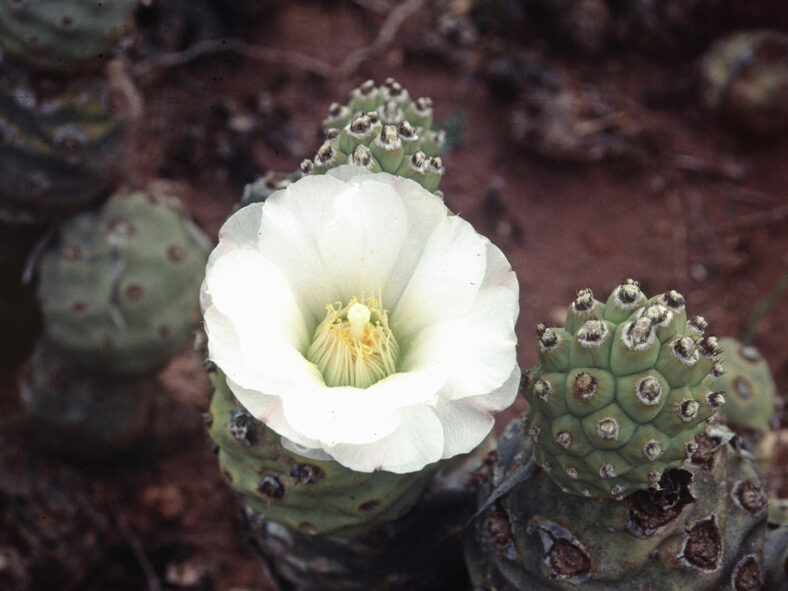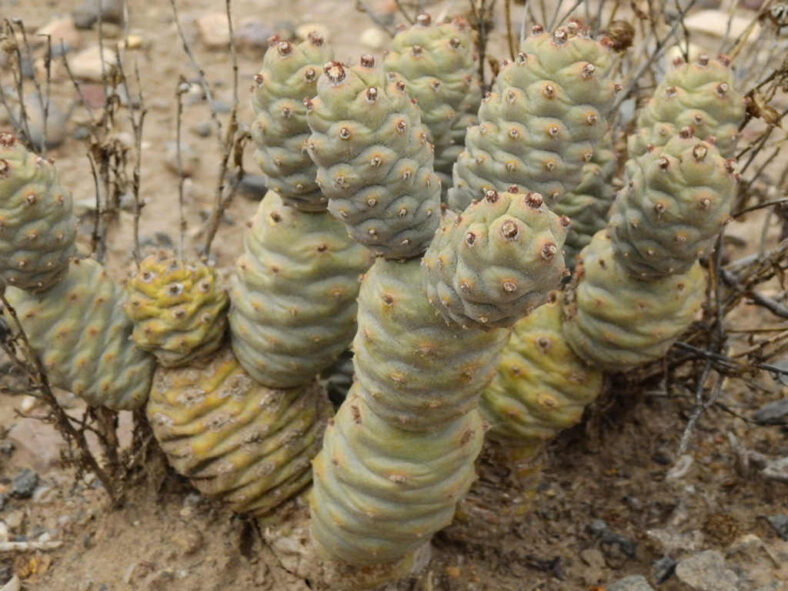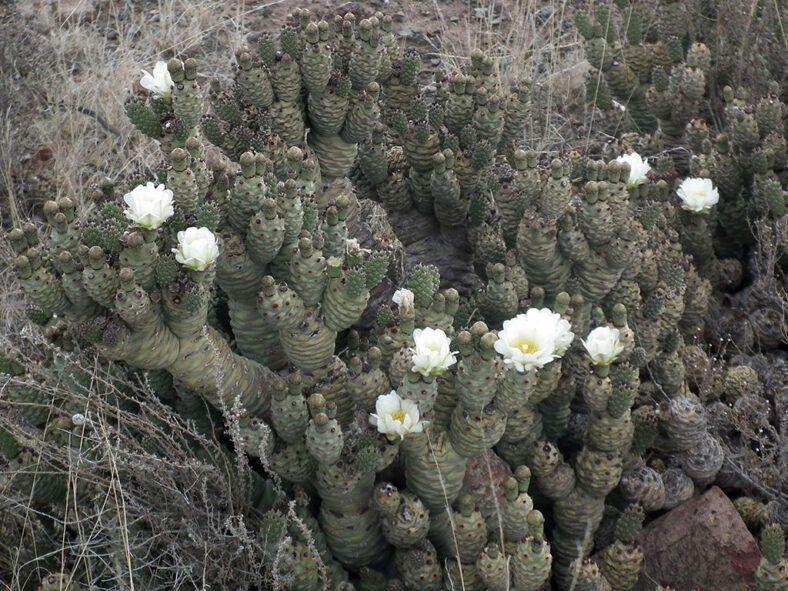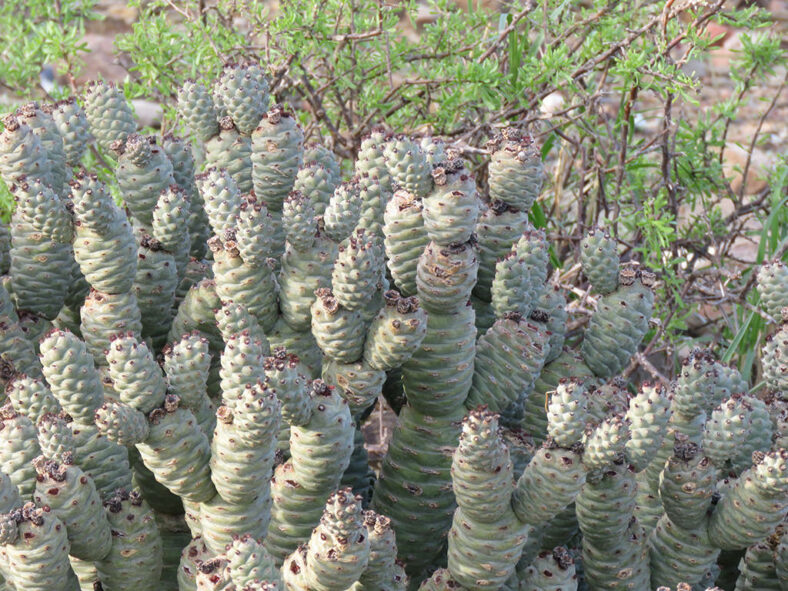Tephrocactus articulatus is probably the most variable species in the genus, resulting in an excess of scientific names. It is popular among cactus growers due to its diversity of interesting and artistic forms.
Scientific Name
Tephrocactus articulatus (Otto) Backeb.
Common Name(s)
Pine Cone Cactus, Spruce Cone Cholla
Synonym(s)
Cereus articulatus, Opuntia articulata
Scientific Classification
Family: Cactaceae
Subfamily: Opuntioideae
Tribe: Tephrocacteae
Genus: Tephrocactus
Etymology
The specific epithet "articulatus" (pronounced "ar-tik-oo-LAH-tus") means "articulated, jointed" and refers to the appearance of the attachment points of the stem segments of this species.
Origin
Tephrocactus articulatus is native to Argentina. It occurs in Catamarca, Cordoba, La Rioja, Mendoza, Salta, San Luis, and Santiago del Estero.
Description
Tephrocactus articulatus is a small cactus with erect, loosely branching stems composed of pinecone-shaped, green to gray-green segments. It can grow up to 12 inches (30 cm) tall, forming an upright shrub. The stem segments are ovoid to short-cylindrical, prominently tuberculate, usually tenuously attached, and easily dislodged. They can reach up to 4 inches (10 cm) in length and up to 1.6 inches (4 cm) in diameter, but are usually 1.2 to 2 inches (3 to 5 cm) long and of similar diameter. The tubercles are spirally arranged and tipped with small, almost round, woolly areoles that bear red to purplish black glochids and sometimes 1 to 4 flattened, flexible spines.
In the spring, Tephrocactus articulatus produces beautiful white to light pink flowers with pericarpels covered with spineless areoles. The flowers can measure up to 1.8 inches (4.5 cm) long. The fruits are brown, depressed, and spherical and can grow up to 0.9 inches (2.2 cm) in length and diameter.

How to Grow and Care for Tephrocactus articulatus
Light: Tephrocactus articulatus thrives in full sun, but some shade during midday and afternoon can prevent sunburn in hot climates. When grown indoors, a window that receives sunlight for 6 hours a day works best.
Soil: This cactus requires a well-draining soil mix. You can use a commercial cactus potting mix or create your own.
Temperature: Extremely tolerant of high temperatures, Tephrocactus articulatus prefers cooler temperatures in winter. It grows best in USDA Plant Hardiness Zones 8b to 10b, with average minimum winter temperatures ranging from 15 to 40 °F (-9.4 to 4.4 °C).
Watering: From spring to fall, water moderately and let the soil dry out completely before watering again. In most areas, rainfall will be enough for established plants. If potted, never let the container sit in water. During the winter, suspend the watering.
Fertilizing: Tephrocactus articulatus does not need fertilizer when planted in the ground. However, it will benefit from fertilizing during the growing season in a container. Apply a water-soluble fertilizer. Suspend feeding during the winter when the plant goes dormant.
Repotting: Repot only when the cactus becomes potbound or is too large and unstable in its container. Choose a slightly larger container with drainage holes at the bottom. The best time for repotting is late winter or early spring.
Propagation: You can propagate Tephrocactus articulatus by stem segments or seeds. Using stem segments is the easiest method and yields faster results. For best results, take stem segments in early summer. Sow the seeds in late spring.
Learn more at How to Grow and Care for Opuntia.
Toxicity of Tephrocactus articulatus
Tephrocactus articulatus is not toxic to humans or pets. However, it is best kept away from pets and children as its glochids may cause skin irritation.
Varieties and Forms of Tephrocactus articulatus
- Tephrocactus articulatus var. diadematus
- Tephrocactus articulatus var. inermis
- Tephrocactus articulatus var. papyracanthus
Links
- Back to genus Tephrocactus
- Succupedia: Browse succulents by Scientific Name, Common Name, Genus, Family, USDA Hardiness Zone, Origin, or cacti by Genus
Photo Gallery
Click on a photo to see a larger version.


